Target Information
| Target General Information | Top | |||||
|---|---|---|---|---|---|---|
| Target ID |
T32282
(Former ID: TTDR00418)
|
|||||
| Target Name |
Prolactin (PRL)
|
|||||
| Synonyms |
GHA1
Click to Show/Hide
|
|||||
| Gene Name |
PRL
|
|||||
| Target Type |
Discontinued target
|
[1] | ||||
| Disease | [+] 1 Target-related Diseases | + | ||||
| 1 | Multiple sclerosis [ICD-11: 8A40] | |||||
| Function |
Prolactin acts primarily on the mammary gland by promoting lactation.
Click to Show/Hide
|
|||||
| BioChemical Class |
Somatotropin/prolactin
|
|||||
| UniProt ID | ||||||
| Sequence |
MNIKGSPWKGSLLLLLVSNLLLCQSVAPLPICPGGAARCQVTLRDLFDRAVVLSHYIHNL
SSEMFSEFDKRYTHGRGFITKAINSCHTSSLATPEDKEQAQQMNQKDFLSLIVSILRSWN EPLYHLVTEVRGMQEAPEAILSKAVEIEEQTKRLLEGMELIVSQVHPETKENEIYPVWSG LPSLQMADEESRLSAYYNLLHCLRRDSHKIDNYLKLLKCRIIHNNNC Click to Show/Hide
|
|||||
| 3D Structure | Click to Show 3D Structure of This Target | PDB | ||||
| HIT2.0 ID | T86YQL | |||||
| Drugs and Modes of Action | Top | |||||
|---|---|---|---|---|---|---|
| Discontinued Drug(s) | [+] 1 Discontinued Drugs | + | ||||
| 1 | NTx-488 | Drug Info | Discontinued in Phase 2 | Multiple sclerosis | [2] | |
| Mode of Action | [+] 1 Modes of Action | + | ||||
| Modulator | [+] 1 Modulator drugs | + | ||||
| 1 | NTx-488 | Drug Info | [1] | |||
| Cell-based Target Expression Variations | Top | |||||
|---|---|---|---|---|---|---|
| Cell-based Target Expression Variations | ||||||
| Different Human System Profiles of Target | Top |
|---|---|
|
Human Similarity Proteins
of target is determined by comparing the sequence similarity of all human proteins with the target based on BLAST. The similarity proteins for a target are defined as the proteins with E-value < 0.005 and outside the protein families of the target.
A target that has fewer human similarity proteins outside its family is commonly regarded to possess a greater capacity to avoid undesired interactions and thus increase the possibility of finding successful drugs
(Brief Bioinform, 21: 649-662, 2020).
Human Tissue Distribution
of target is determined from a proteomics study that quantified more than 12,000 genes across 32 normal human tissues. Tissue Specificity (TS) score was used to define the enrichment of target across tissues.
The distribution of targets among different tissues or organs need to be taken into consideration when assessing the target druggability, as it is generally accepted that the wider the target distribution, the greater the concern over potential adverse effects
(Nat Rev Drug Discov, 20: 64-81, 2021).
Human Pathway Affiliation
of target is determined by the life-essential pathways provided on KEGG database. The target-affiliated pathways were defined based on the following two criteria (a) the pathways of the studied target should be life-essential for both healthy individuals and patients, and (b) the studied target should occupy an upstream position in the pathways and therefore had the ability to regulate biological function.
Targets involved in a fewer pathways have greater likelihood to be successfully developed, while those associated with more human pathways increase the chance of undesirable interferences with other human processes
(Pharmacol Rev, 58: 259-279, 2006).
Biological Network Descriptors
of target is determined based on a human protein-protein interactions (PPI) network consisting of 9,309 proteins and 52,713 PPIs, which were with a high confidence score of ≥ 0.95 collected from STRING database.
The network properties of targets based on protein-protein interactions (PPIs) have been widely adopted for the assessment of target’s druggability. Proteins with high node degree tend to have a high impact on network function through multiple interactions, while proteins with high betweenness centrality are regarded to be central for communication in interaction networks and regulate the flow of signaling information
(Front Pharmacol, 9, 1245, 2018;
Curr Opin Struct Biol. 44:134-142, 2017).
Human Similarity Proteins
Human Tissue Distribution
Human Pathway Affiliation
Biological Network Descriptors
|
|
|
There is no similarity protein (E value < 0.005) for this target
|
|
Note:
If a protein has TS (tissue specficity) scores at least in one tissue >= 2.5, this protein is called tissue-enriched (including tissue-enriched-but-not-specific and tissue-specific). In the plots, the vertical lines are at thresholds 2.5 and 4.
|
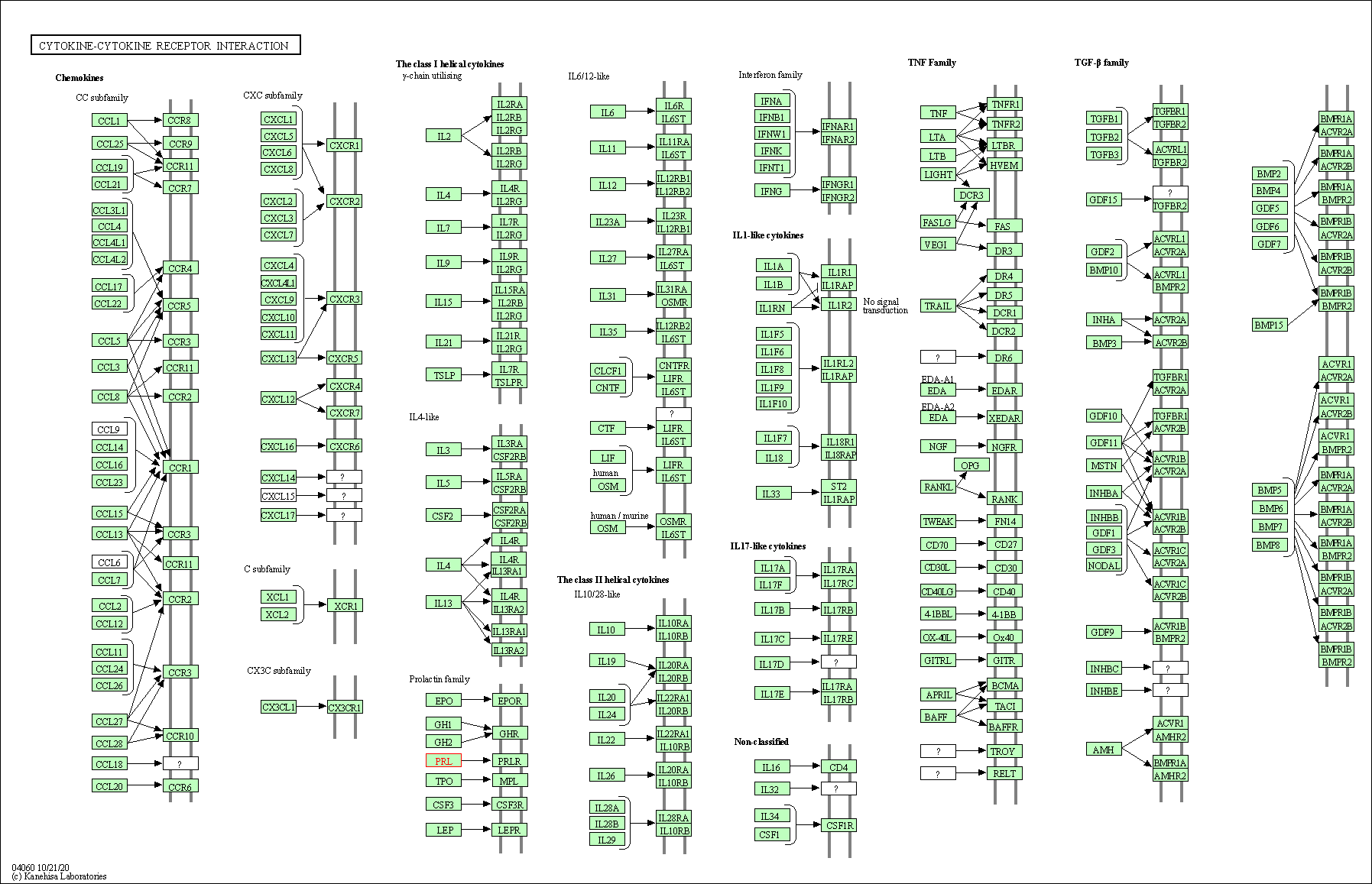
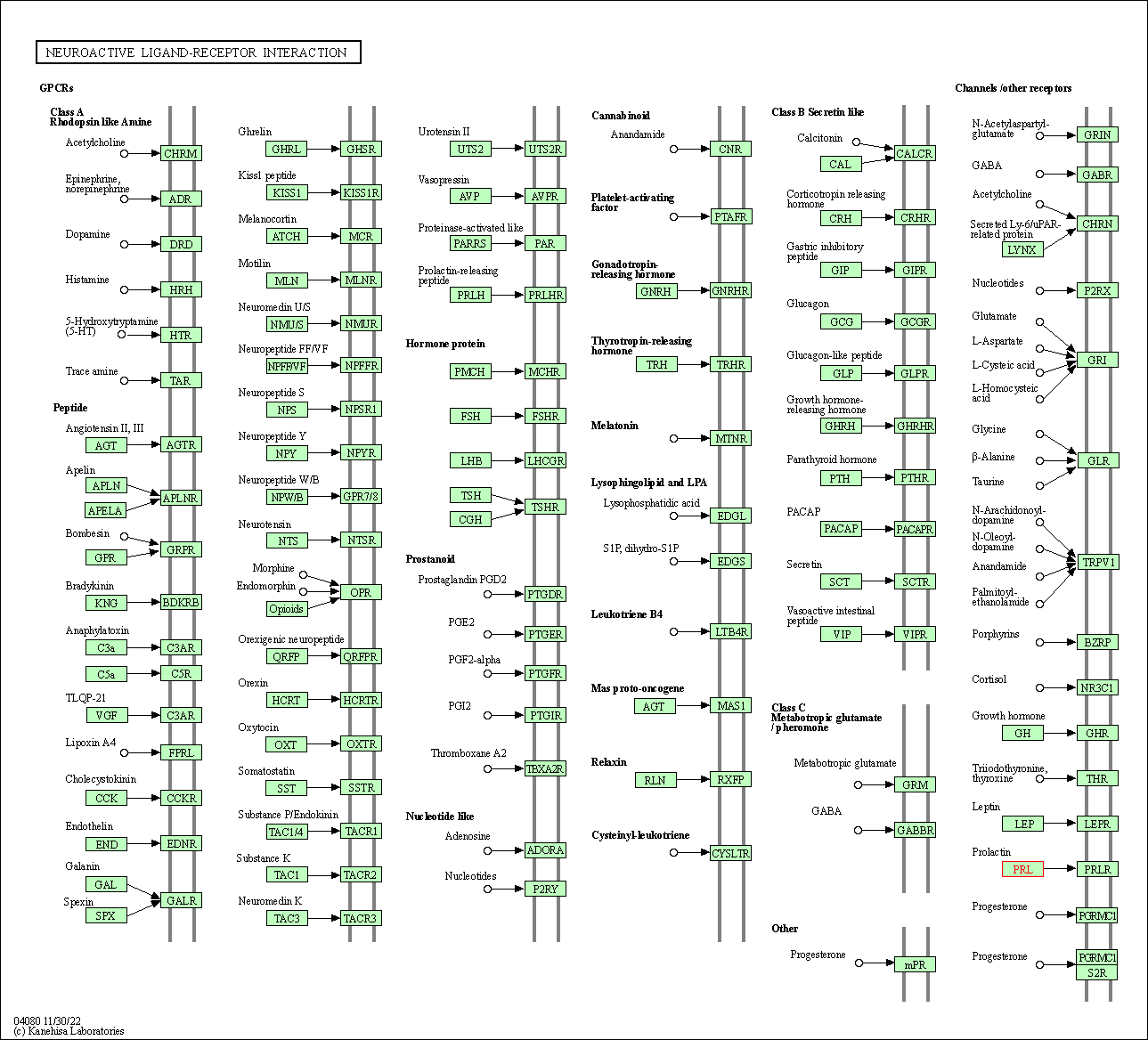
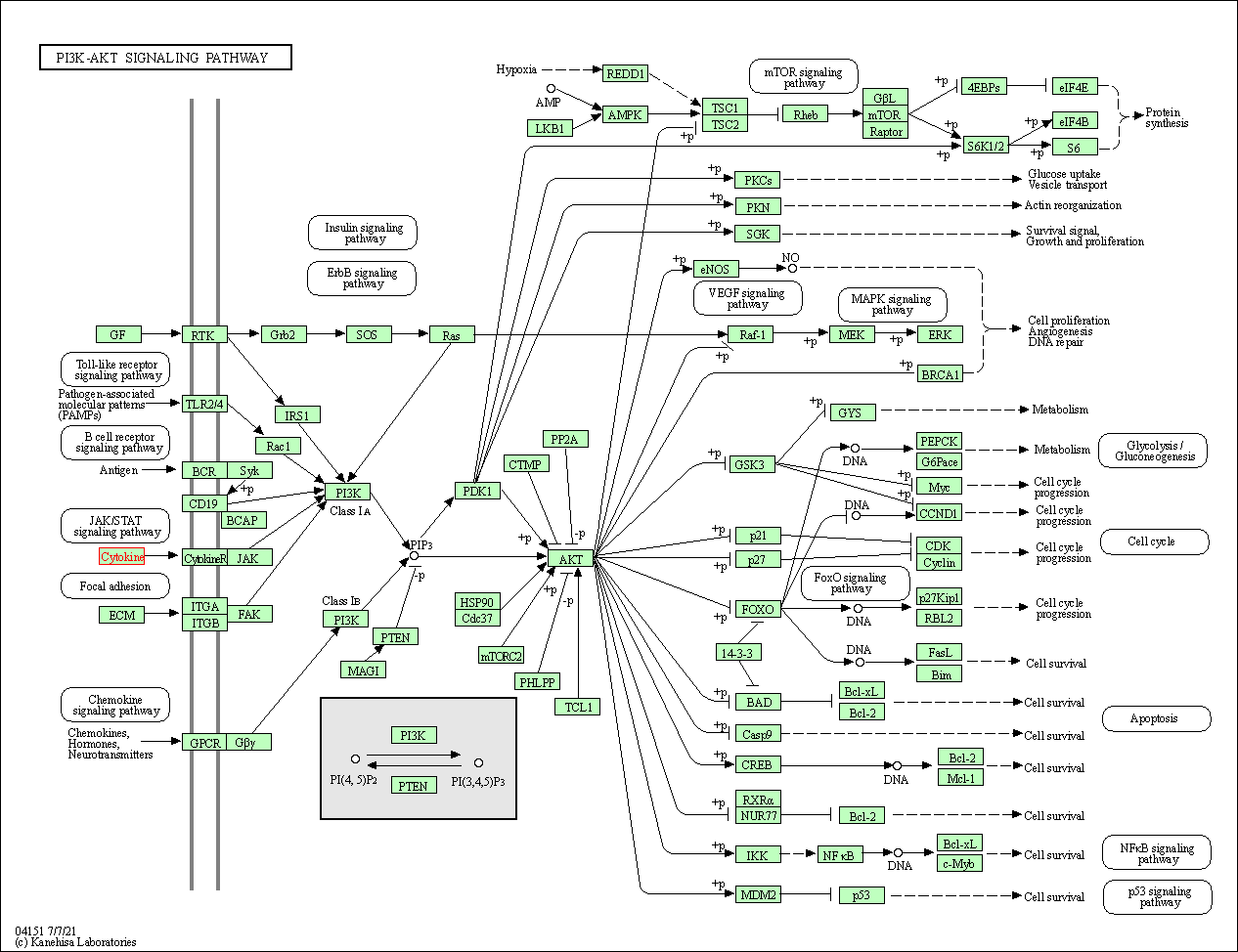
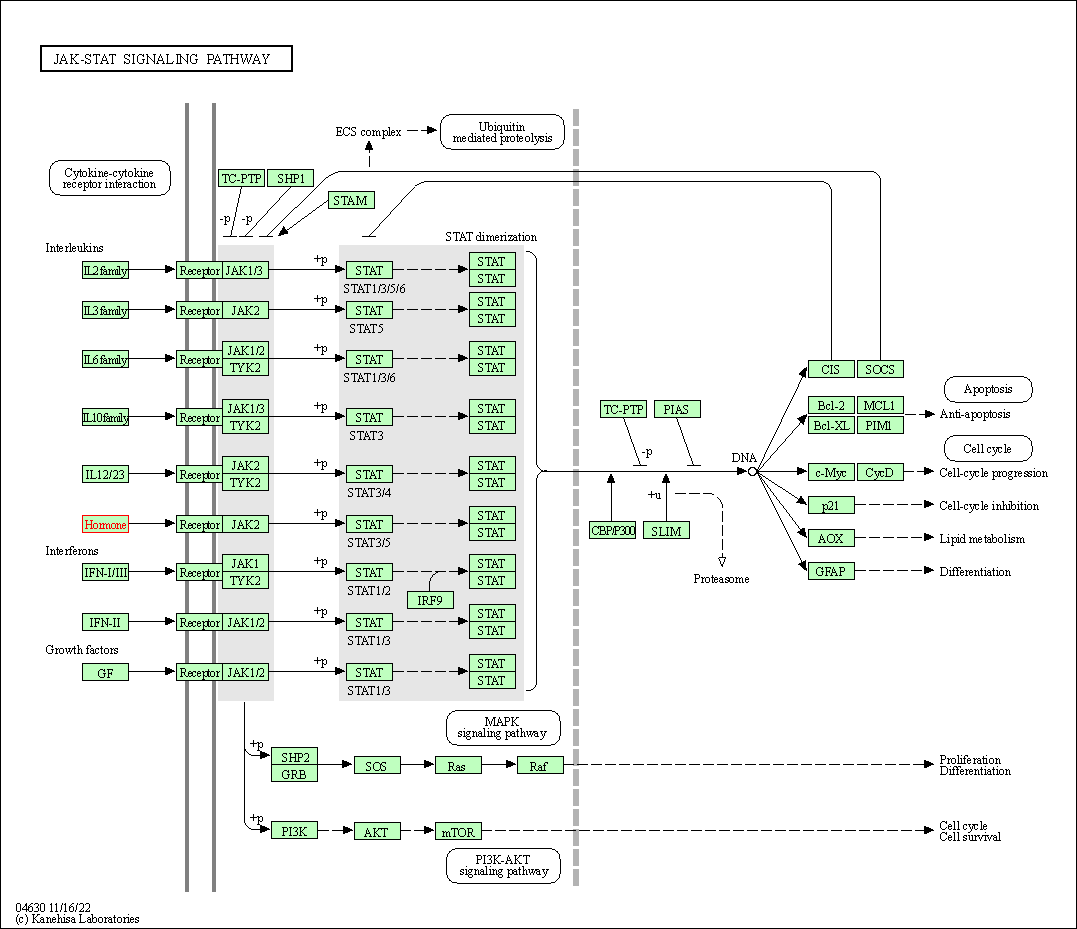
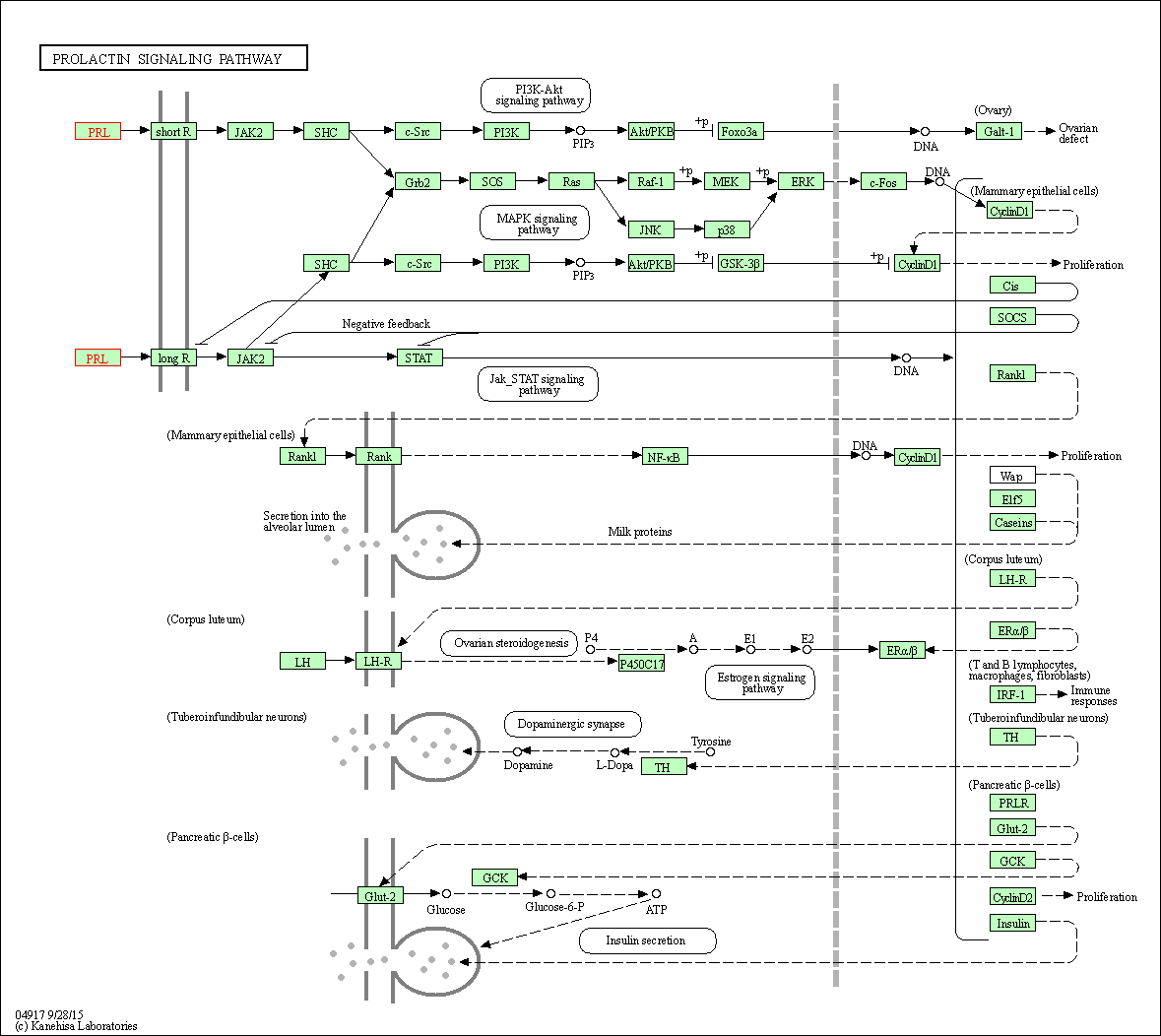
| KEGG Pathway | Pathway ID | Affiliated Target | Pathway Map |
|---|---|---|---|
| Cytokine-cytokine receptor interaction | hsa04060 | Affiliated Target |

|
| Class: Environmental Information Processing => Signaling molecules and interaction | Pathway Hierarchy | ||
| Neuroactive ligand-receptor interaction | hsa04080 | Affiliated Target |

|
| Class: Environmental Information Processing => Signaling molecules and interaction | Pathway Hierarchy | ||
| PI3K-Akt signaling pathway | hsa04151 | Affiliated Target |

|
| Class: Environmental Information Processing => Signal transduction | Pathway Hierarchy | ||
| JAK-STAT signaling pathway | hsa04630 | Affiliated Target |

|
| Class: Environmental Information Processing => Signal transduction | Pathway Hierarchy | ||
| Prolactin signaling pathway | hsa04917 | Affiliated Target |

|
| Class: Organismal Systems => Endocrine system | Pathway Hierarchy | ||
| Degree | 3 | Degree centrality | 3.22E-04 | Betweenness centrality | 0.00E+00 |
|---|---|---|---|---|---|
| Closeness centrality | 2.10E-01 | Radiality | 1.37E+01 | Clustering coefficient | 1.00E+00 |
| Neighborhood connectivity | 4.53E+01 | Topological coefficient | 4.24E-01 | Eccentricity | 12 |
| Download | Click to Download the Full PPI Network of This Target | ||||
| Target Regulators | Top | |||||
|---|---|---|---|---|---|---|
| Target-regulating Transcription Factors | ||||||
| Target Profiles in Patients | Top | |||||
|---|---|---|---|---|---|---|
| Target Expression Profile (TEP) |
||||||
| Target Affiliated Biological Pathways | Top | |||||
|---|---|---|---|---|---|---|
| KEGG Pathway | [+] 5 KEGG Pathways | + | ||||
| 1 | Cytokine-cytokine receptor interaction | |||||
| 2 | Neuroactive ligand-receptor interaction | |||||
| 3 | PI3K-Akt signaling pathway | |||||
| 4 | Jak-STAT signaling pathway | |||||
| 5 | Prolactin signaling pathway | |||||
| NetPath Pathway | [+] 1 NetPath Pathways | + | ||||
| 1 | IL2 Signaling Pathway | |||||
| PID Pathway | [+] 4 PID Pathways | + | ||||
| 1 | ErbB4 signaling events | |||||
| 2 | Signaling events mediated by PTP1B | |||||
| 3 | Glucocorticoid receptor regulatory network | |||||
| 4 | Validated nuclear estrogen receptor alpha network | |||||
| Reactome | [+] 3 Reactome Pathways | + | ||||
| 1 | Prolactin receptor signaling | |||||
| 2 | Amyloid formation | |||||
| 3 | Growth hormone receptor signaling | |||||
| WikiPathways | [+] 5 WikiPathways | + | ||||
| 1 | Prostaglandin Synthesis and Regulation | |||||
| 2 | EV release from cardiac cells and their functional effects | |||||
| 3 | Prolactin receptor signaling | |||||
| 4 | Growth hormone receptor signaling | |||||
| 5 | JAK/STAT | |||||
| References | Top | |||||
|---|---|---|---|---|---|---|
| REF 1 | Trusted, scientifically sound profiles of drug programs, clinical trials, safety reports, and company deals, written by scientists. Springer. 2015. Adis Insight (drug id 800028330) | |||||
| REF 2 | Trusted, scientifically sound profiles of drug programs, clinical trials, safety reports, and company deals, written by scientists. Springer. 2015. Adis Insight (drug id 800028330) | |||||
If You Find Any Error in Data or Bug in Web Service, Please Kindly Report It to Dr. Zhou and Dr. Zhang.

